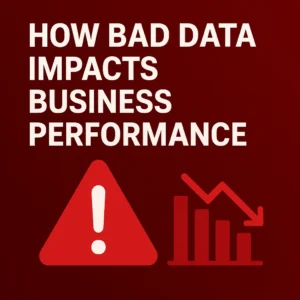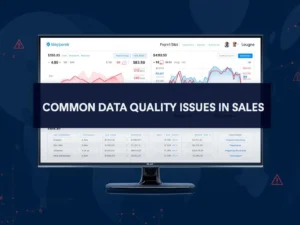Fixing data quality issues in sales and marketing starts with one essential step—understanding where your data breaks down. In today’s digital-first marketing landscape, decisions are powered by data. Every campaign, lead score, customer journey, and sales forecast depends on clean, accurate, and reliable information. Yet, many marketers struggle with outdated, duplicated, or inconsistent data that silently undermines performance. Poor data quality doesn’t just affect reports—it impacts every stage of the sales funnel, from targeting and personalization to revenue tracking and ROI measurement.

To fix data quality issues, marketers must begin with a structured data management strategy. This involves auditing existing databases, identifying gaps, and implementing consistent data collection practices across tools like CRMs, marketing automation platforms, and analytics dashboards. According to a MarTech report, more than 30% of B2B marketers say inaccurate or incomplete data causes them to miss revenue opportunities.
The next step is to integrate automation and validation tools that clean and standardize information in real time. Platforms such as HubSpot, Salesforce, and Zapier can automatically detect duplicates, correct formatting errors, and enrich missing fields with verified data sources. Additionally, building a culture of data ownership—where sales and marketing teams share responsibility for data accuracy—ensures long-term consistency.
Ultimately, high-quality data drives better segmentation, personalized messaging, and smarter decisions. When marketers trust their data, they can confidently launch campaigns that convert, align with sales teams more effectively, and improve customer experiences.
In this guide, we’ll explore the most common data quality challenges marketers face, the tools that help solve them, and actionable strategies to keep your CRM and marketing database clean, consistent, and campaign-ready in 2025.
What Is Data Quality in Sales?
Data quality in sales refers to how well your sales data meets the needs of your business processes, decision-making, and strategic goals. It’s not just about having lots of data—it’s about having accurate, complete, consistent, timely, and valid data that is “fit for use” in your sales operations. TechTarget+2lakeFS+2
In the sales context, poor data quality can lead to duplication of leads, incomplete customer profiles, outdated contact information, or records that conflict across systems. For example, if a prospect’s email address is wrong, your outreach fails; if pipeline stages aren’t updated consistently, forecasting becomes unreliable. Salesgenie+2TechTarget+2
To illustrate, here are key dimensions of data quality as they apply in sales:
-
Accuracy: Data should correctly reflect reality (e.g. correct names, emails).
-
Completeness: All essential fields (company, phone, industry) should be filled.
-
Consistency: Format and values should align across systems (CRM, marketing tools).
-
Timeliness: Data should be up-to-date (e.g. changes in contact info reflected quickly).
-
Uniqueness: Avoid duplicate records representing the same lead or customer.
-
Validity: Data should conform to formats and business rules (e.g. country codes, valid email patterns). sailpoint.com+2TechTarget+2
When sales data is high quality, your team can trust dashboards, identify trends, score leads, and forecast reliably. However, low-quality data breeds inefficiency, missed opportunities, wrong targeting, poor customer relationships, and flawed strategy decisions.
How Bad Data Impacts Business Performance
1. Introduction: The Hidden Cost of Bad Data
In today’s data-driven world, businesses rely on accurate information to make smart decisions. But when that data is incomplete, outdated, or inconsistent, it can quietly drain company resources. Studies show that poor data quality costs organizations up to 20% of their revenue annually — a figure that underscores just how damaging bad data can be.
2. Lost Revenue and Missed Opportunities
Bad data directly affects sales and marketing performance. When contact lists are filled with duplicates or incorrect customer details, marketing campaigns fail to reach the right audience. This results in wasted ad spend, poor targeting, and lower conversion rates.
For example, sending promotional emails to invalid addresses doesn’t just waste money — it also damages your domain reputation, reducing future deliverability and engagement.
3. Inefficient Operations and Higher Costs
Data errors ripple across departments. Sales teams waste time chasing incorrect leads, finance teams make inaccurate forecasts, and supply chains overstock or understock products. These inefficiencies lead to operational delays, wasted resources, and increased costs.
A simple mistake in inventory data, for example, could mean overproduction or stockouts — both hurting profitability and customer satisfaction.

4. Damaged Customer Experience
Customer experience depends heavily on personalized, accurate interactions. When businesses rely on bad data, they risk sending irrelevant offers, repeating the same messages, or missing key customer needs. Over time, this leads to loss of trust and decreased loyalty.
Customers expect brands to “know” them — and when data fails, the relationship weakens.
5. Poor Decision-Making and Strategic Errors
Executives make strategic decisions based on reports and analytics. If that foundation is flawed, the outcomes can be disastrous. Inaccurate data can distort sales trends, mislead investment choices, and create false confidence in performance metrics.
Ultimately, poor data integrity prevents leaders from identifying real growth opportunities.
6. The Path to Better Data
Fixing data quality isn’t just a tech issue — it’s a business priority. Regular data audits, validation tools, and integration platforms like VoiceTotal can help ensure accurate, real-time information across all systems.
When businesses maintain clean, consistent data, they unlock better decisions, stronger customer relationships, and higher revenue growth.
Common Data Quality Issues in Sales
1. Why Data Quality Matters in Sales
In modern sales operations, data is the backbone of every decision — from lead generation to conversion tracking. However, when sales data is inaccurate, incomplete, or duplicated, it can derail performance and revenue growth. According to Gartner, poor data quality costs organizations an average of $12.9 million per year, impacting forecasting, targeting, and customer relationships.
To understand the problem, let’s explore the most common data quality issues affecting sales teams today.
2. Duplicate Records
Duplicate entries are one of the most common and damaging issues in sales databases. When the same lead or customer appears multiple times with slightly different information, sales reps waste valuable time following up twice, or even worse — send conflicting offers.
This confusion leads to inefficient communication and a poor customer experience. Using automated CRM tools and validation platforms like VoiceTotal’s call tracking and analytics solutions can help detect and remove duplicates early.
Learn more about improving data-driven accuracy on voicetotal.com/blog.
3. Incomplete or Missing Information
Many sales teams struggle with incomplete data, such as missing contact numbers, job titles, or company names. Without full customer details, lead scoring and segmentation become nearly impossible. As a result, marketing messages may not reach the right people, reducing overall conversion potential.
Regular audits and AI-powered enrichment tools can help fill these gaps, ensuring every sales record is complete and useful.

4. Outdated or Inaccurate Data
Customer data changes constantly — phone numbers, email addresses, or company roles evolve over time. Outdated data leads to missed opportunities, as sales teams continue chasing inactive leads or old contacts.
Implementing real-time call tracking and automated updates ensures data stays current and relevant, giving teams a competitive edge.
5. Data Silos and Lack of Integration
When data is stored in separate systems — like CRM, call tracking, and email marketing platforms — teams lose a unified view of the customer journey. This disconnect results in miscommunication, double work, and inaccurate reporting.
Integrating all data sources through platforms like VoiceTotal ensures seamless flow and a single source of truth for decision-making.
6. Conclusion: Clean Data = Strong Sales
Maintaining data accuracy is not a one-time task — it’s a continuous process. By identifying and fixing these common issues, sales teams can improve forecasting, personalize outreach, and close more deals.
To explore more insights on data management and sales performance, visit voicetotal.com/blog.
The Importance of Data Quality in Sales and Marketing
In today’s competitive digital landscape, data is the foundation of every successful sales and marketing strategy. From identifying potential leads to personalizing campaigns and measuring ROI, every decision relies on accurate and reliable data. Poor data quality, on the other hand, can derail even the best strategies — wasting time, money, and resources.
1. Data Drives Better Decision-Making
Good data helps businesses make smarter, faster, and more confident decisions. When sales and marketing teams have access to clean, updated information, they can identify trends, target the right audience, and measure results effectively. Inaccurate data often leads to misguided decisions, missed opportunities, and incorrect forecasts that impact overall business growth.
2. Improved Lead Targeting and Conversion
High-quality data ensures that sales and marketing teams focus their efforts on the right prospects. With accurate demographic, behavioral, and engagement data, marketers can create personalized campaigns that resonate with their audience. Sales teams can also prioritize qualified leads, reducing wasted effort on irrelevant contacts and boosting conversion rates.
3. Enhanced Customer Experience
Data accuracy is crucial for creating seamless customer experiences. When your data is clean, your emails reach the right people, your offers are relevant, and your customer interactions feel personal. On the other hand, outdated or incorrect data can result in communication errors, duplicate messages, or irrelevant offers — damaging your brand reputation and customer trust.
4. Better Alignment Between Sales and Marketing
When both departments work with consistent, high-quality data, collaboration becomes much easier. A shared, accurate data source helps align marketing campaigns with sales goals, ensuring smoother lead handoffs and more effective follow-ups. This alignment ultimately drives better performance and higher ROI across both teams.
5. Maximizing ROI and Reducing Wastage
Clean data ensures that marketing budgets are used efficiently. Accurate analytics reveal which channels bring the most qualified leads and which campaigns need improvement. By eliminating bad data, businesses can save costs on wrong contacts, invalid emails, or poor targeting — and reinvest in strategies that actually drive revenue.
In the world of sales and marketing, data quality isn’t optional — it’s essential. Clean, accurate, and reliable data empowers teams to make better decisions, deliver exceptional experiences, and drive sustainable business growth.
For more insights on data-driven marketing and sales optimization, visit VoiceTotal.com/blog.
How to Fix Data Quality Issues in Sales
In today’s data-driven world, your sales performance is only as strong as the quality of your data. When sales teams rely on incomplete, outdated, or duplicated information, it can lead to poor decisions, missed opportunities, and lost revenue. The good news? You can fix data quality issues with a structured, proactive approach that focuses on accuracy, automation, and accountability.
1. Identify and Audit Your Current Data
The first step is awareness. Conduct a data quality audit to identify inconsistencies, missing fields, or outdated contacts in your CRM or sales systems. Analyze where most errors occur — whether from manual entry, form submissions, or imports from other platforms. Regular audits create transparency and set a clear baseline for improvement.
2. Automate Data Collection and Validation
Manual data entry is one of the biggest sources of error. Implement automation tools to collect, clean, and verify data in real time. Platforms like VoiceTotal help streamline call tracking and customer data capture, ensuring that every record is accurate and complete. Automated validation checks — like email verification or duplicate detection — reduce human error significantly.
3. Standardize Data Entry and Formats
Create clear data entry standards for your sales team. This includes consistent formatting for phone numbers, addresses, and names. Use dropdown menus and pre-set fields where possible to maintain uniformity. Standardization ensures that data from different team members and sources aligns perfectly, improving reporting and analytics accuracy.
4. Integrate All Data Sources
Data silos often create fragmented insights. Integrate your CRM, call tracking software, marketing automation tools, and analytics dashboards into one ecosystem. With a centralized data hub, sales teams can access complete and updated information instantly — improving decision-making and collaboration.
5. Continuously Monitor and Maintain
Data management isn’t a one-time project — it’s an ongoing process. Schedule periodic reviews to detect new errors, update outdated contacts, and maintain compliance with privacy standards. The best-performing sales teams treat data maintenance as a daily routine, not an afterthought.
Clean, accurate data fuels better sales performance, higher conversion rates, and smarter marketing decisions. By using automated tools like VoiceTotal and following these best practices, businesses can transform their sales data into a reliable growth engine.
For more insights on data quality, automation, and sales optimization, visit our blog at VoiceTotal.com/blog.
Tools and Platforms for Improving Data Quality
Several tools can help businesses improve their data quality:
-
HubSpot: Provides CRM tools to maintain clean and organized customer data.
-
Call Tracking Software: Tracks sales calls, ensuring you capture valuable data from customer interactions.
For more insights on CRM tools, check our related blog on improving lead accuracy with call tracking.
